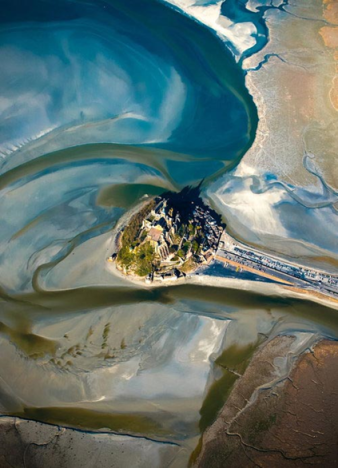
“The faery solitude of the place…his castle that lay on the very bosom of the sea…. at home neither on land or water, a mysterious amphibious place, contravening the materiality of both earth and waves…That lovely, sad, sea-siren of a place!.” The Bloody Chamber, p.8-9
This very brief analysis explores how we can approach gendered relations from the perspective of location to reveal the symbolic and metaphorical significance of Mont. Saint- Michel as it is employed in Angela Carter’s The Bloody Chamber. This analysis was given recently in a very short presentation. Examining Mont. Saint- Michel I explore its potential to represent feminine and masculine principles, nature and culture and how it is central to relations between the bride, her mother and the Marquis. Working through visual and sonic imagery highlights the relations between female anatomy, biology and the cyclical feminine flow ontology of the ‘sea-girt’. My interest lay specifically in the concept of the sea-girt, as a border or boundary surrounded or enclosed by the sea and how we might consider this in relation to the porous and the feminine.
Fluid osmotic imagery ebbs and flows throughout The Bloody Chamber. Rocked in the cradle of the deep, “there is no room or corridor that does not rustle with the sound of the sea.” Her “nightdress supple as a garment of heavy water”, the night; “a permeable substance that seeps into the skin”, the Marquis’ face “like a stone on the beach with fissures eroded by the tides.” His voice likened to the “soft consolations of the sea”, the silvering of the mirrors is fathomless and at times all is silent except for the murmuring waves [1]. These rhythms symbolically represent the flow ontology of the feminine associated with creation myths, the separation of the earth from the sky, water and womb; the oceanic experience of the fetus [2]. According to the feminist philosopher Julia Kristeva this is connected to conceptions of time, linear and monumental. The former is historical and the latter associated with the feminine is cyclical, rhythmic and repetitive [3]. These concepts are woven into the narrative of both the Marquis and his bride.
“I smelled the amniotic salinity of the ocean…” [4]
The logic of the phallus embodied in the vertical “turrets of misty blue” suppresses the sensible and the material, these turrets lie “on the very bosom of the sea” [5]. The masculine conception of the abstract, the concrete and the universal spirits away the body, sexual difference, the sensible, material and the particular. If the Marquis’ history legitimizes his exercise of power it seems doubly ironic that not only is he haunted by the feminine but also occupies an aborted location, the Mount, surround by the “amniotic salinity of the ocean.” This concept caused me to reconsider the relations between the bride and her mother and the “logic of the umbilical cord” which Luce Irigaray defines as “an image for the power of motherhood and the maternal principle.” [6] This is echoed in the causeway or umbilical cord linking the island to the mainland, the continual flow of the tides and the phone call to the mother whereby the phone line functions metaphorically as the umbilical cord. I would suggest that it is this logic that enables the mother to sense her daughter’s distress even though in the final act this cord had been cut. The line she says was dead, “dead as his wives.” [7]
In the theatre of representation the geographic and cartographic privileging of vision disembodies the eye. This in turn reduces the politics of location to the measurable and the knowable, a god like perspective that elides the texture of place. Within this visual economy of the sign female difference is defined as lack since there is literally nothing to see as far as her sexuality is concerned. The female protagonists embodied narrative recuperates this lack through a symbolic re-arrangement engendering subject and object, content and form, figure and ground. Through the continual transgression of symbolic borders this mapping of female identity is only ever partial like Mont. Saint-Michel itself. If one is on it one cannot see it and there is no single vantage point that can take in its entirety. The construction of The Bloody Chamber in that sense is like a multi-faceted jewel or in Carters own words a fascination with “the play of surfaces” and the “rhythms of the tides.” [8]
[1] Angela Carter, The Bloody Chamber (Vintage Books: London 2006) p.9, p.2, p.29, p.3, p.15 respectively [2] This term refers to the undifferentiated and unbounded experience of the fetus. The origin of this terms it appears was that of Romain Rollan in relation to religious experience which troubled Sigmund Freud and was taken up in Civilization and its Discontents 1930. http://www.academia.edu/864000/The_oceanic_feeling_and_a_sea_change_Historical_challenges_to_reductionist_attitudes_to_religion_and_spirit_from_within_psychoanalysis (accessed Feb 3rd 2013) [3] Julia Kristeva in Inger Birkeland, Making Place, Making Self, Travel, Subjectivity and Sexual Difference (Ashgate Publishing Limited, Hants: England 2005), p.91 [4] Ibid, p.8 [5] Op.cit, p.13 [6] This is Inger Birkeland’s term for the ‘fluid metaphysics’ proposed by Julia Kristeva and Luce Irigaray. Luce Irigaray quoted in Birkeland, Ibid, p.143. [6] Op.cit, p.8. [7] Op.cit, p.29. [8] Op.cit, p.x and p.31 respectively.
Image reproduced from http://www.mostbeautifulpictures.net/tag/mont-saint-michel/ 29012014.